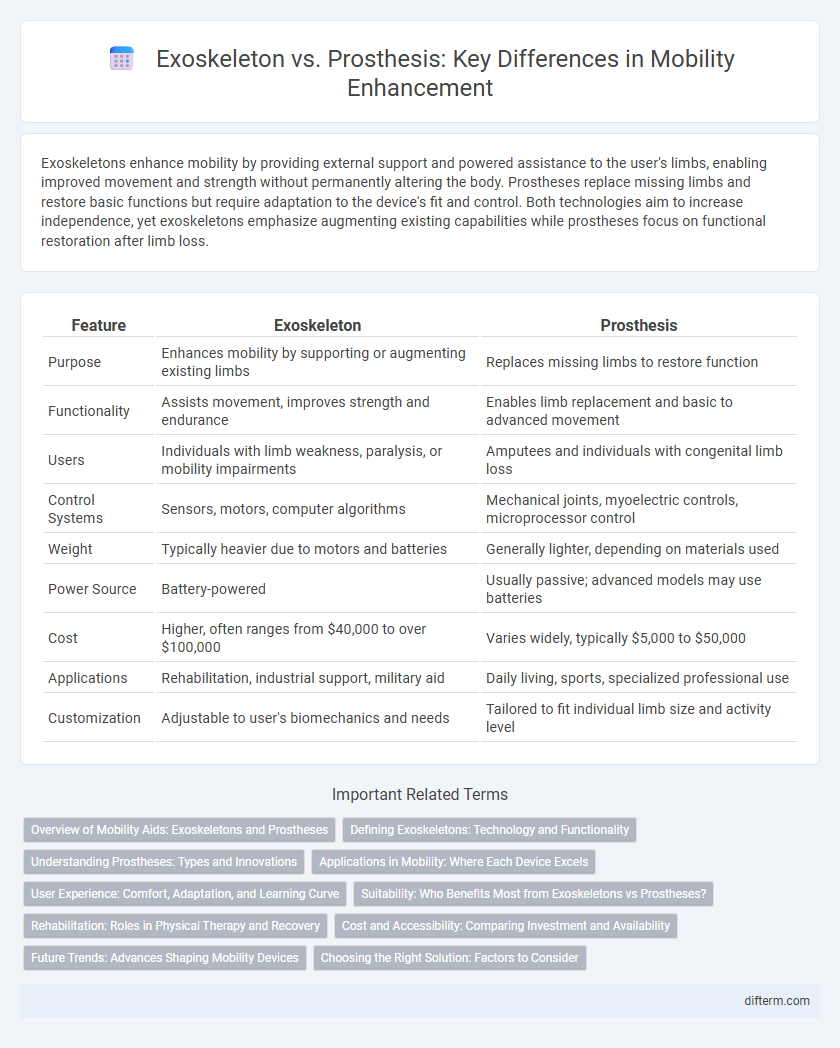Exoskeletons enhance mobility by providing external support and powered assistance to the user's limbs, enabling improved movement and strength without permanently altering the body. Prostheses replace missing limbs and restore basic functions but require adaptation to the device's fit and control. Both technologies aim to increase independence, yet exoskeletons emphasize augmenting existing capabilities while prostheses focus on functional restoration after limb loss.
Table of Comparison
| Feature | Exoskeleton | Prosthesis |
|---|---|---|
| Purpose | Enhances mobility by supporting or augmenting existing limbs | Replaces missing limbs to restore function |
| Functionality | Assists movement, improves strength and endurance | Enables limb replacement and basic to advanced movement |
| Users | Individuals with limb weakness, paralysis, or mobility impairments | Amputees and individuals with congenital limb loss |
| Control Systems | Sensors, motors, computer algorithms | Mechanical joints, myoelectric controls, microprocessor control |
| Weight | Typically heavier due to motors and batteries | Generally lighter, depending on materials used |
| Power Source | Battery-powered | Usually passive; advanced models may use batteries |
| Cost | Higher, often ranges from $40,000 to over $100,000 | Varies widely, typically $5,000 to $50,000 |
| Applications | Rehabilitation, industrial support, military aid | Daily living, sports, specialized professional use |
| Customization | Adjustable to user's biomechanics and needs | Tailored to fit individual limb size and activity level |
Overview of Mobility Aids: Exoskeletons and Prostheses
Exoskeletons are wearable robotic devices designed to enhance or restore mobility by supporting or augmenting body movement, often used in rehabilitation or for individuals with paralysis. Prostheses replace missing limbs and are custom-fitted to restore functionality and improve gait, with advanced versions incorporating myoelectric sensors for more natural motion. Both technologies significantly improve independence but serve different purposes: exoskeletons assist existing limbs, while prostheses substitute for lost ones.
Defining Exoskeletons: Technology and Functionality
Exoskeletons are wearable robotic devices designed to enhance human mobility by supporting and amplifying natural movement through sensor-driven actuators and real-time feedback systems. Unlike prostheses, which replace missing limbs, exoskeletons augment existing body parts, providing assistance in walking, lifting, or rehabilitation for individuals with muscle weakness or neurological impairments. Advanced materials such as lightweight alloys and soft robotics enable exoskeletons to deliver adaptive support while maintaining user comfort and energy efficiency.
Understanding Prostheses: Types and Innovations
Prostheses encompass a range of devices designed to replace missing limbs, with types including cosmetic, body-powered, and myoelectric prosthetics that use muscle signals for movement. Recent innovations focus on lightweight materials, enhanced sensory feedback, and improved joint articulation to increase functionality and user comfort. Advancements in neural integration and machine learning algorithms have propelled the development of intuitive control systems, making prostheses more responsive and adaptive to individual mobility needs.
Applications in Mobility: Where Each Device Excels
Exoskeletons excel in enhancing mobility for individuals with lower limb paralysis by providing external support and powered assistance for walking, standing, and posture control. Prostheses are tailored for limb replacement, enabling amputees to regain natural movement and dexterity through biomechanical design and advanced sensors. In rehabilitation, exoskeletons facilitate gait training and muscle strengthening, while prostheses restore functional independence in daily activities and sports.
User Experience: Comfort, Adaptation, and Learning Curve
Exoskeletons offer enhanced comfort through adjustable fittings and distributed weight, promoting longer wear times compared to prostheses, which may cause pressure points and require custom socket modifications. Adaptation to exoskeletons involves mastering control interfaces and balance assistance, typically resulting in a shorter learning curve due to intuitive motion support, whereas prosthesis users often face extensive training to achieve smooth, coordinated movements. User experience improves with exoskeletons by providing real-time feedback and adaptable movement patterns, enabling faster rehabilitation and greater mobility confidence than conventional prosthetic devices.
Suitability: Who Benefits Most from Exoskeletons vs Prostheses?
Exoskeletons are most suitable for individuals with partial mobility impairments who retain some muscle function and seek enhanced strength or endurance in walking or standing tasks. Prostheses benefit those with complete limb loss, providing a functional replacement to restore mobility and enable daily activities. Selection depends on the level of limb functionality, rehabilitation goals, and the specific mobility challenges faced by the user.
Rehabilitation: Roles in Physical Therapy and Recovery
Exoskeletons enhance rehabilitation by supporting limb movement, improving muscle strength, and facilitating repetitive motion for patients recovering from spinal cord injuries or strokes. Prostheses restore lost limb function by enabling basic mobility and aiding balance, often customized to individual gait patterns during physical therapy. Combining exoskeletons and prostheses in recovery protocols accelerates motor relearning, reduces muscle atrophy, and improves overall patient outcomes in mobility restoration.
Cost and Accessibility: Comparing Investment and Availability
Exoskeletons typically require significantly higher upfront investment, often ranging from $40,000 to $100,000, compared to prostheses which generally cost between $5,000 and $50,000, making prosthetics more accessible to a broader population. Availability of prosthetics is widespread with established manufacturing and fitting centers globally, while exoskeleton technology remains limited to specialized clinics and research institutions. Maintenance costs and the need for trained personnel further restrict exoskeleton accessibility, whereas prosthetic devices benefit from a more extensive support infrastructure.
Future Trends: Advances Shaping Mobility Devices
Future trends in mobility devices emphasize the integration of AI-powered exoskeletons offering enhanced gait adaptability and real-time biomechanical feedback. Innovations in lightweight, durable materials are driving the development of prostheses with improved sensory perception and neural interface capabilities. These advancements are converging to provide more intuitive, efficient, and personalized mobility solutions for users with varying physical needs.
Choosing the Right Solution: Factors to Consider
Choosing between an exoskeleton and a prosthesis depends on factors such as the level of mobility impairment, intended use, and individual goals. Exoskeletons are ideal for individuals seeking to enhance existing mobility or regain walking ability post-injury, while prostheses better suit those with limb loss requiring limb replacement. Consider weight, comfort, control system, and cost to ensure optimal functionality and user satisfaction.
exoskeleton vs prosthesis Infographic

 difterm.com
difterm.com